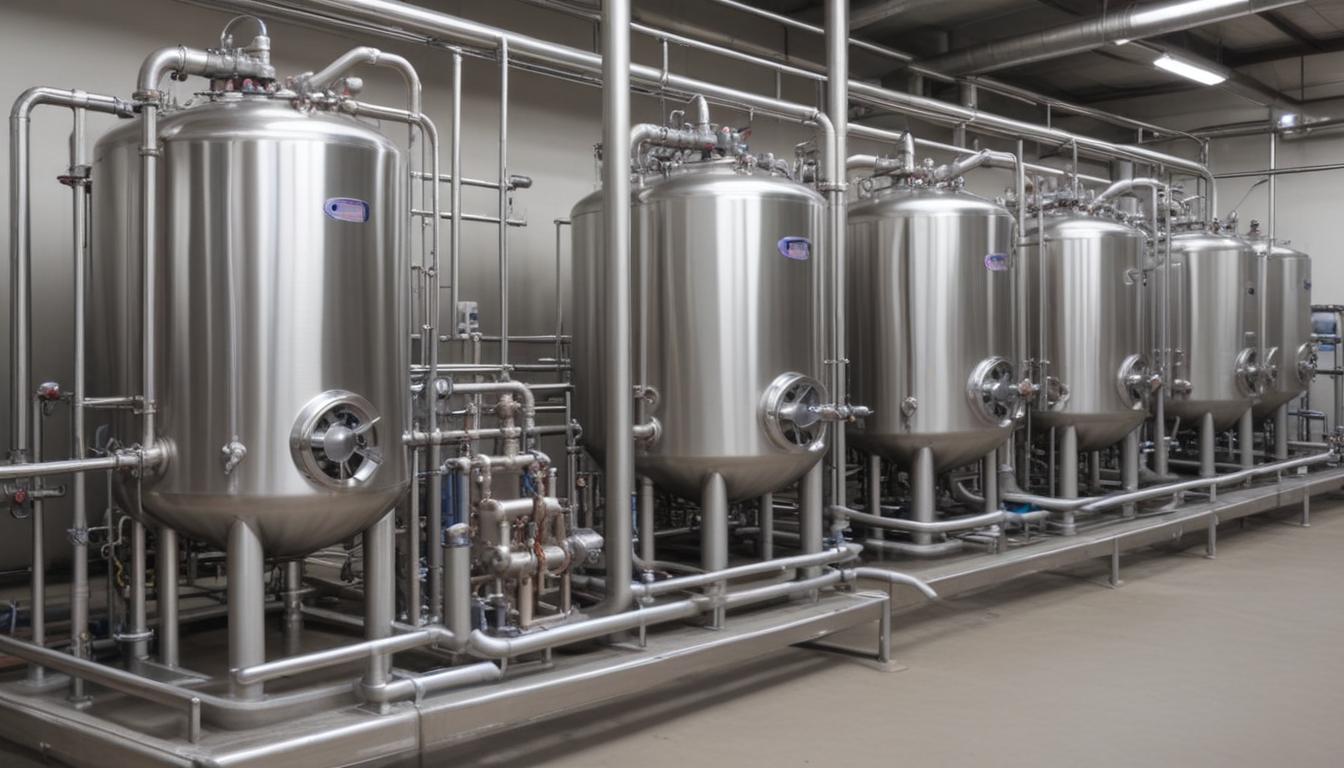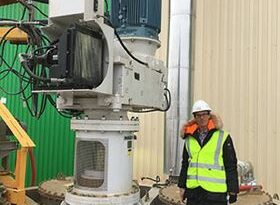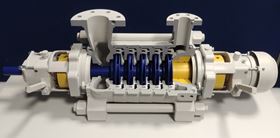pumps used in the food pasteurization process
Food pasteurization requires precise and reliable pumping solutions to ensure the integrity and safety of products. Several types of pumps are commonly employed in this process, each offering unique advantages tailored to specific applications.
- Centrifugal Pumps:
- Functionality: Utilize rotational energy to move fluids by converting kinetic energy to pressure.
- Applications: Ideal for handling large volumes of liquid with low viscosity, making them suitable for continuous pasteurization processes.
- Advantages: Simple design, cost-effective, and easy to maintain.
- Positive Displacement Pumps:
- Gear Pumps: Employ interlocking gears to move fluid, providing a steady and precise flow rate. Suitable for viscous liquids used in certain pasteurization applications.
- Diaphragm Pumps: Use a reciprocating diaphragm to displace fluid, offering excellent control and suitability for hygienic applications where contamination must be minimized.
- Peristaltic Pumps:
- Functionality: Move fluids through a flexible tube by compressing it with rollers, ensuring gentle handling of sensitive liquids.
- Applications: Ideal for pasteurizing heat-sensitive products such as certain beverages and dairy alternatives.
- Advantages: Easy to clean, reduce the risk of contamination, and allow for precise flow control.
- Lobe Pumps:
- Design: Feature multiple lobes that rotate to move fluid, ensuring a smooth and pulsation-free flow.
- Applications: Suitable for high-viscosity and particulate-laden fluids common in some pasteurized foods.
- Advantages: Gentle handling of products, minimal shear stress, and high reliability.
Food pasteurization pumps must be selected based on factors such as fluid characteristics, required flow rates, and maintenance considerations. Understanding the various types and their specific functionalities ensures optimal performance and product quality in pasteurization processes.
selection criteria for pasteurization
When selecting the appropriate food pasteurization pumps, several critical factors must be meticulously evaluated to ensure optimal performance and compliance with safety standards. The primary selection criteria include:
- Fluid Characteristics:
- Viscosity: The thickness of the fluid affects the type of pump required. For high-viscosity liquids, positive displacement pumps such as gear or lobe pumps are often preferred.
- Temperature: Pumps must withstand the operating temperatures of pasteurization processes, typically ranging from 60°C to 85°C. Materials used in pump construction should maintain integrity and performance under these conditions.
- Corrosiveness: Fluids with acidic or alkaline properties necessitate pumps made from corrosion-resistant materials like stainless steel or specialized polymers.
- Particulate Content: Fluids containing solids or particulates require pumps with features that prevent clogging and allow for easy cleaning, such as diaphragm or peristaltic pumps.
- Flow Rate and Pressure Requirements:
Parameter Considerations Flow Rate Determine the volume of fluid to be processed per unit time to select a pump that can handle peak and average flow rates without compromising performance. Pressure Assess the pressure needed to achieve desired pasteurization temperatures and ensure the pump can maintain consistent pressure levels throughout the process. - Hygienic Design and Compliance:
- Regulatory Standards: Ensure pumps comply with industry standards such as FDA, NSF, or EHEDG for hygienic applications.
- Cleanability: Pumps should feature smooth surfaces, minimal crevices, and easy disassembly to facilitate thorough cleaning and prevent microbial contamination.
- Sanitary Features: Incorporate sanitary seals, gaskets, and connections to maintain aseptic conditions during pasteurization.
- Material Compatibility and Construction:
- Material Selection: Choose materials that are compatible with the processed fluid to avoid reactions that could degrade the pump or contaminate the product.
- Construction Quality: High-quality construction ensures durability and longevity, reducing the need for frequent replacements and minimizing downtime.
- Energy Efficiency and Operational Reliability:
- Energy Consumption: Select pumps that offer high energy efficiency to reduce operational costs and environmental impact.
- Reliability: Opt for pumps with proven track records and robust designs that can operate continuously without frequent failures.
- Maintenance and Support:
- Ease of Maintenance: Pumps should be designed for easy access to components for routine maintenance and troubleshooting.
- Manufacturer Support: Choose suppliers that offer comprehensive support, including spare parts availability and technical assistance.
By meticulously evaluating these criteria, manufacturers and operators can select the most suitable food pasteurization pumps that align with their specific applications, ensuring efficient, safe, and reliable pasteurization processes.
materials and construction
Materials and construction play a pivotal role in the performance and longevity of food pasteurization pumps. Selecting the appropriate materials ensures not only the integrity of the pump but also compliance with strict hygiene and safety standards essential in food processing applications.
- Stainless Steel:
- Austenitic Stainless Steels (e.g., 304, 316): These are the most commonly used materials in food pasteurization pumps due to their excellent corrosion resistance, ease of cleaning, and ability to withstand high temperatures. Grade 316 stainless steel, in particular, offers superior resistance to chlorides and is ideal for environments where acidic or saline solutions are present.
- Ferritic and Martensitic Stainless Steels: While less common, these grades can be used in applications requiring higher strength and hardness. However, they may have lower corrosion resistance compared to austenitic grades.
- Food-Grade Polymers:
- Polypropylene (PP): Known for its chemical resistance and durability, PP is suitable for handling a wide range of food products, including acidic liquids.
- Polyethylene (PE): Utilized in components such as seals and gaskets, PE offers flexibility and resistance to moisture and many chemicals.
- Polytetrafluoroethylene (PTFE): Commonly used for seals and gaskets, PTFE provides excellent non-stick properties and can withstand a broad temperature range, making it ideal for high-temperature pasteurization processes.
- Seals and Gaskets:
- Viton: Resistant to high temperatures and a variety of chemicals, Viton is frequently used in pumps that handle aggressive fluids.
- Silicone: Offers excellent flexibility and thermal stability, suitable for applications requiring frequent movement and sealing integrity.
- EPDM (Ethylene Propylene Diene Monomer): Ideal for sealing applications involving water and steam, EPDM provides reliable performance in many pasteurization scenarios.
- Construction Quality:
- Seamless Design: Pumps designed with seamless construction minimize crevices and dead zones where contaminants can accumulate, enhancing hygiene and ease of cleaning.
- Welded Joints: High-quality welded joints ensure the structural integrity of the pump, preventing leaks and contamination.
- Machining Precision: Precise machining of pump components ensures tight tolerances, reducing wear and extending the pump’s operational lifespan.
| Material | Properties | Applications |
|---|---|---|
| 304 Stainless Steel | Excellent corrosion resistance, good formability, and weldability. | General-purpose food pasteurization pumps handling a variety of liquids. |
| 316 Stainless Steel | Superior corrosion resistance, especially against chlorides and acidic solutions. | Applications involving saline or acidic food products. |
| PTFE Seals | Non-stick, high-temperature resistant, chemically inert. | Pumps handling high-temperature fluids and aggressive chemicals. |
| Polypropylene Components | Durable, chemically resistant, lightweight. | Components in pumps for handling various food and beverage products. |
Hygienic Design Features are critical in the construction of food pasteurization pumps to prevent contamination and ensure compliance with food safety regulations. Key design elements include:
- Smooth Internal Surfaces: Minimizing surface roughness reduces the harboring of bacteria and facilitates easier cleaning.
- Easy Disassembly: Pumps should be designed for quick and straightforward disassembly to allow thorough cleaning and maintenance.
- Sanitary Connections: Use of sanitary flanges and fittings ensures leak-proof and contamination-free connections between pump components and process lines.
- No Dead Zones: Design pumps to eliminate areas where product can stagnate, ensuring consistent flow and minimizing microbial growth.
In summary, the selection of materials and construction techniques for food pasteurization pumps directly impacts their suitability for specific applications, durability, and compliance with hygiene standards. By utilizing high-quality, food-grade materials and incorporating hygienic design principles, manufacturers can ensure their pumps meet the stringent requirements of the food pasteurization process.
maintenance and troubleshooting
 Effective upkeep is essential to ensure the longevity and optimal performance of food pasteurization pumps. Regular maintenance not only prevents unexpected downtime but also safeguards product quality and safety. Implementing a comprehensive maintenance strategy involves routine inspections, timely replacements of worn components, and adherence to manufacturer guidelines.
Effective upkeep is essential to ensure the longevity and optimal performance of food pasteurization pumps. Regular maintenance not only prevents unexpected downtime but also safeguards product quality and safety. Implementing a comprehensive maintenance strategy involves routine inspections, timely replacements of worn components, and adherence to manufacturer guidelines.
Preventive Maintenance Practices
Adopting a preventive maintenance approach minimizes the risk of pump failures and extends the service life of equipment. Key practices include:
- Scheduled Inspections: Conduct routine checks to identify wear and tear on critical components such as seals, gaskets, and bearings. Regular inspections help detect issues before they escalate.
- Cleaning Procedures: Ensure that pumps are thoroughly cleaned after each use to prevent contamination and buildup of residues. Use appropriate cleaning agents that are compatible with the pump materials.
- Lubrication: Maintain proper lubrication of moving parts to reduce friction and prevent overheating. Follow the manufacturer’s recommendations for lubricant types and application intervals.
- Component Replacement: Replace consumable parts like seals, O-rings, and bearings at recommended intervals to maintain pump integrity and performance.
- Calibration and Alignment: Regularly calibrate pump controls and ensure proper alignment of pump and motor shafts to prevent undue stress and mechanical failures.
Maintenance Schedule Example
| Maintenance Task | Frequency | Details |
|---|---|---|
| Visual Inspection | Daily | Check for leaks, unusual noises, and general condition of the pump. |
| Lubrication | Weekly | Apply lubricant to bearings and other moving parts as per manufacturer’s guidelines. |
| Seal and Gasket Inspection | Monthly | Examine seals and gaskets for signs of wear or damage; replace if necessary. |
| Performance Monitoring | Monthly | Evaluate flow rates, pressure levels, and temperature to ensure they meet operational standards. |
| Comprehensive Overhaul | Annually | Perform detailed maintenance, including disassembly, cleaning, and replacement of major components. |
Troubleshooting Common Issues
Even with diligent maintenance, issues may arise that require prompt troubleshooting to prevent process interruptions. Common problems and their solutions include:
- Leakage:
- Cause: Worn seals or gaskets.
- Solution: Inspect and replace damaged seals or gaskets. Ensure proper installation to prevent future leaks.
- Reduced Flow Rate:
- Cause: Blockages, worn impellers, or air entrainment.
- Solution: Clean the pump internals to remove any obstructions. Inspect impellers for wear and replace if necessary. Check for and eliminate sources of air ingress.
- Unusual Noises:
- Cause: Misalignment, unbalanced rotors, or cavitation.
- Solution: Align pump and motor shafts accurately. Balance rotors and inspect for signs of cavitation, adjusting operating conditions as needed.
- Vibrations:
- Cause: Loose mounting, imbalance, or worn bearings.
- Solution: Tighten mounting bolts, balance rotating parts, and replace or lubricate bearings as required.
- Overheating:
- Cause: Insufficient lubrication, excessive friction, or high ambient temperatures.
- Solution: Ensure proper lubrication levels. Inspect for and reduce sources of excessive friction. Implement cooling measures if necessary.
Key Considerations for Different Pump Types
Maintenance requirements can vary depending on the type of pump used in the pasteurization process:
- Centrifugal Pumps: Focus on inspecting impellers and ensuring the casing remains free of debris to maintain efficient operation.
- Positive Displacement Pumps: Pay close attention to the condition of gears or diaphragms, as these components are critical for maintaining consistent flow rates.
- Peristaltic Pumps: Regularly check and replace the flexible tubing to prevent wear and maintain gentle handling of sensitive products.
- Lobe Pumps: Inspect lobes for wear and ensure smooth rotation to prevent product damage and maintain flow consistency.
Utilizing Diagnostic Tools
Advanced diagnostic tools can enhance maintenance efficiency and accuracy:
- Vibration Analysis: Detect imbalances, misalignments, or bearing failures through regular vibration monitoring.
- Thermography: Identify hotspots that may indicate friction issues or impending component failures.
- Flow Meters and Pressure Gauges: Continuously monitor pump performance parameters to quickly identify deviations from normal operating conditions.
Training and Documentation
Ensuring that maintenance personnel are well-trained and have access to detailed documentation is crucial:
- Training Programs: Provide comprehensive training on pump operation, maintenance procedures, and troubleshooting techniques specific to different pump types.
- Maintenance Logs: Keep accurate records of all maintenance activities, inspections, and repairs to track pump performance trends and facilitate informed decision-making.
- Manufacturer Manuals: Refer to pump-specific manuals for detailed instructions, specifications, and guidelines to ensure adherence to best practices.
By implementing structured maintenance and effective troubleshooting strategies, operators can ensure that their food pasteurization pumps remain reliable and efficient, thereby supporting consistent and safe pasteurization processes across various applications.
advancements in pump technology
Advancements in pump technology have significantly enhanced the efficiency, reliability, and safety of food pasteurization pumps. These innovations address the evolving needs of the food industry, ensuring that pasteurization processes remain both effective and compliant with stringent regulatory standards. Key advancements include the integration of smart technologies, energy-efficient designs, and improved materials that extend pump lifespan while reducing maintenance requirements.
- Smart Pump Systems:
- IoT Integration: Modern pumps are increasingly equipped with Internet of Things (IoT) capabilities, allowing for real-time monitoring and data collection. This connectivity enables operators to track pump performance, detect anomalies, and optimize operations remotely.
- Automated Control Systems: Advanced control systems utilize artificial intelligence and machine learning algorithms to automatically adjust pump parameters based on real-time data, ensuring consistent flow rates and pressure levels critical for effective pasteurization.
- Predictive Maintenance: By analyzing data trends, smart pump systems can predict potential failures before they occur, allowing for timely maintenance and minimizing downtime.
- Energy Efficiency Improvements:
- Variable Frequency Drives (VFDs): VFDs adjust the motor speed to match the required load, reducing energy consumption during periods of lower demand. This not only lowers operational costs but also minimizes the environmental impact of the pasteurization process.
- Advanced Motor Technologies: New motor designs offer higher efficiency rates, converting more electrical energy into mechanical energy with less waste. This results in more efficient pump operation and reduced energy bills.
- Enhanced Materials and Coatings:
- Corrosion-Resistant Alloys: The use of advanced alloys and protective coatings extends the lifespan of pump components, particularly in environments with aggressive fluids. Materials such as duplex stainless steels and titanium alloys provide superior resistance to corrosion and wear.
- Non-Stick Coatings: These coatings reduce the adherence of pasteurization fluids to pump surfaces, facilitating easier cleaning and minimizing the risk of microbial contamination.
- Improved Seal and Bearing Technologies:
- Mechanical Seals: Modern mechanical seals offer enhanced reliability and longer service intervals compared to traditional seal types. They prevent leaks more effectively, maintaining the hygienic integrity of the pasteurization process.
- Advanced Bearings: New bearing materials and lubrication technologies reduce friction and wear, resulting in smoother pump operation and extended maintenance intervals.
- Compact and Modular Designs:
- Space-Saving Configurations: Compact pump designs are increasingly favored in facilities with limited space. These designs integrate multiple components into a single unit, simplifying installation and reducing the overall footprint.
- Modular Components: Modular designs allow for easy customization and scalability. Operators can add or replace components without significant downtime, accommodating varying applications and production demands.
- Enhanced Hygiene Features:
- Straight-Through Flow Paths: Eliminating sharp bends and crevices in pump design reduces areas where contaminants can accumulate, enhancing the hygienic performance of the pump.
- Sanitary Fasteners and Connections: Improved fastening systems ensure leak-proof and easy-to-clean connections, maintaining aseptic conditions throughout the pasteurization process.
| Technological Advancement | Description | Benefits |
|---|---|---|
| IoT Integration | Connecting pumps to the internet for real-time data monitoring and control. | Enhanced oversight, reduced downtime, and optimized performance. |
| Variable Frequency Drives (VFDs) | Adjusting motor speeds based on operational demand. | Energy savings and improved system flexibility. |
| Corrosion-Resistant Alloys | Utilizing advanced materials to prevent degradation. | Increased durability and longer pump lifespan. |
| Mechanical Seals | Implementing modern sealing solutions. | Reduced leakage and improved hygiene. |
| Modular Designs | Creating pumps with interchangeable components. | Greater customization and easier maintenance. |
Digitalization and Industry 4.0 have also played pivotal roles in advancing pump technologies. The integration of digital twins—virtual replicas of physical pump systems—allows for comprehensive simulations and testing without disrupting actual operations. This facilitates better design optimization and proactive problem-solving.
Moreover, advancements in 3D printing have enabled the rapid prototyping and production of complex pump components, reducing lead times and allowing for more intricate designs that enhance performance and durability.
Energy Harvesting Technologies are being explored to further improve the sustainability of food pasteurization pumps. These technologies capture and reuse waste energy generated during pump operation, contributing to overall energy efficiency and reducing operational costs.
In addition to hardware innovations, software developments have enhanced pump monitoring and control. Advanced software platforms provide intuitive interfaces for operators to visualize pump performance metrics, receive alerts on potential issues, and implement automated adjustments to maintain optimal conditions.
The convergence of these technological advancements ensures that food pasteurization pumps continue to evolve, meeting the increasing demands for efficiency, reliability, and safety in the food processing industry. By embracing these innovations, manufacturers can enhance their applications, achieve higher productivity, and maintain stringent quality standards essential for effective pasteurization.




